Table of Contents
Are developed pectoral muscles one of your goals? In that case, your training plan should include effective exercises for chest. Undoubtedly, one of the most popular exercises is the bench press, which most people include in their training in the gym. But this is not the only exercise that can help you develop your chest muscles. Some other exercises can target this area from different angles and thus improve the shape and symmetry of your pectoral muscles.
The same rules apply to chest training as for other muscle groups. Before you start, remember to warm up your muscles. It will prepare for the upcoming load. On top of that, warm up protects you from injury. After all, coming to the gym and going straight to your personal record in the bench press is not the healthiest approach. Likewise, the exercise itself has its sequence of progress. Therefore, first, learn the correct technique and then increase the load. That is the only way to achieve the best results.
You can easily create a chest workout in the gym from the exercises below. For a start, all you have to do is choose about 2–3 exercises which you will execute in 3 sets, ranging from 8 to 12 reps in a set. In this case, the weights should fall to about 60-75% 1RM (one rep maximum). You will then include chest training alone or in combination with another muscle group, ideally 2–3 times a week. Bear in mind that complete muscle regeneration after strength training will take place on average in 24–72 hours. Due to the time needed for regeneration, plan your workout and the number of units per week for a specific muscle group. [1–3]
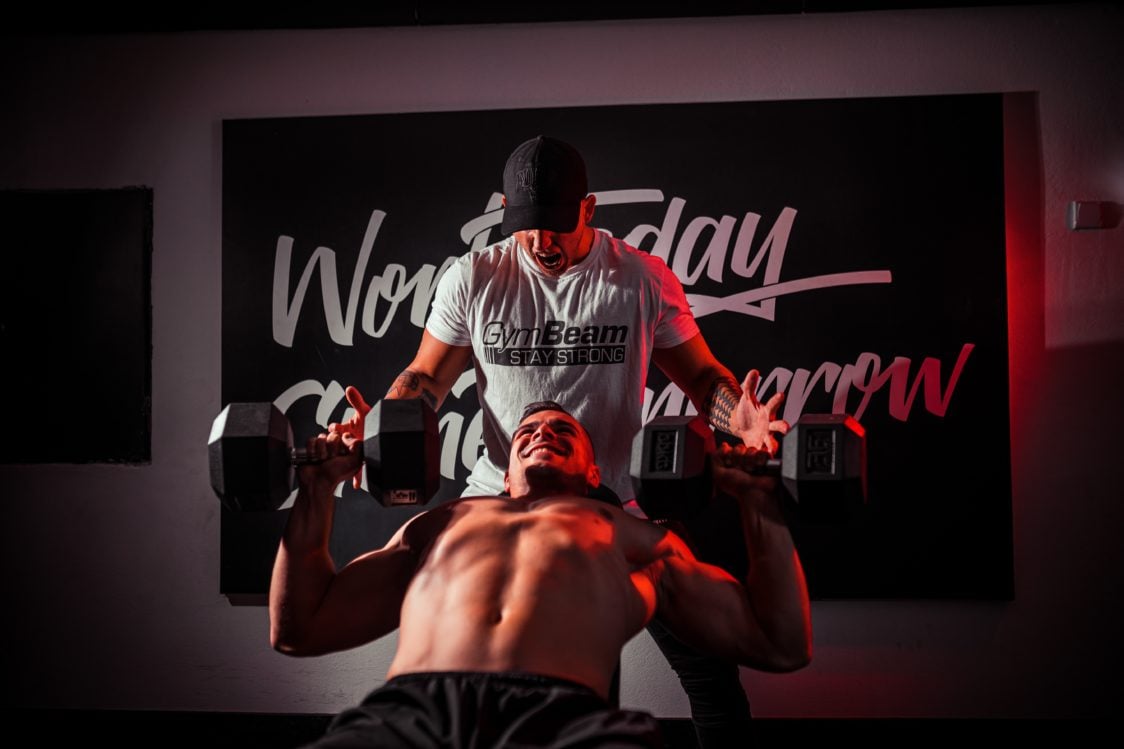
7 Best Chest Exercises for Pectoral Muscles Development
You will only need the standard gym equipment to perform these exercises, such as an adjustable bench, barbell, dumbbells, cable machine, and parallel bars. You can also use long expanders or kettlebells. Then it’s up to you how you combine basic exercises with their slightly different variations. Also, keep in mind that it is necessary to engage the upper, middle, and lower part of the large pectoral muscle (Musculus pectoralis major), which plays a crucial role in the size of the chest.
1. Bench Press
- Starting position: Lie on your back on a horizontal bench. Press your shoulder blades together and grab the bar (overhand grip). Keep your wrists and elbows right under the bar. Your hands should be slightly wider than the shoulder-width. The feet are on the floor during the whole exercise with approx. 90 degrees at your knees. You can slightly bend your back. Activate your core and glutes.
- Performance: Grab the bar above your chest. Then slowly lower it towards your chest while inhaling. The bar should slightly touch the chest in the lower position (approx. in the middle of the sternum). In this position, the arms form an angle of 45-60 degrees with the body. Then press the bar up by activating the chest muscles while exhaling until your arms are almost straight. The upward motion of the bar should create a slight curve. Once you return to the starting position, do the next rep.
- Common mistakes: Elbows point towards the body, uncontrolled movement, improper weights, excessively bent back, insufficient core and glute activation, a small range of motion.
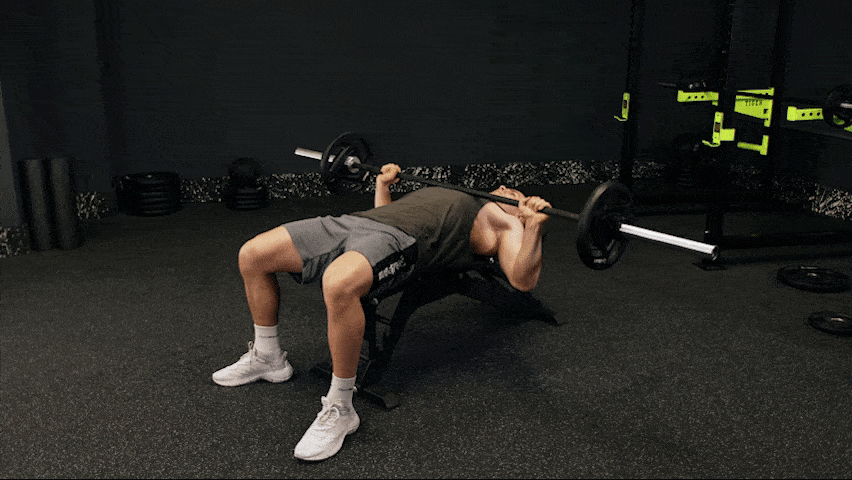
Other exercise variations:
1. Dumbbell Chest Press
If you do not have a barbell, you can perform this exercise with dumbbells. The advantage is that dumbbells allow you to exercise both sides of the body separately and load the muscles in a bigger range of movement. When moving upwards, push the dumbbells together. That will put more load on the inner part of the pectoral muscles.
2. Bench Press with Narrow or Wide Grip
You can easily change muscle activation by adjusting the grip width. In the narrow grip, you will feel triceps, and in the case of the wider one, with your arms farther apart, you will engage your pectoral muscles more intensively.
3. Multi Press Bench Press
For some individuals this exercise might be easier to perform on multi-press. You don’t have to focus so much on stability and watch the movement of the bar.
2. Dumbbell Chest Fly
- Starting position: Lie on your back on a horizontal bench. Rest your feet with the entire surface on the floor. Grab the dumbbells, extend your arms forward, and turn your palms toward one another. Slightly bend your elbows. Activate your core.
- Performance: Spread your arms out slowly with controlled movement while inhaling. Keep your elbows slightly bent. Return your arms to the starting position by activating your pectoral muscles while exhaling. Then move on to the next rep.
- Common mistakes: too bent elbows, uncontrolled movement, inappropriate load, bent back, a small range of motion.
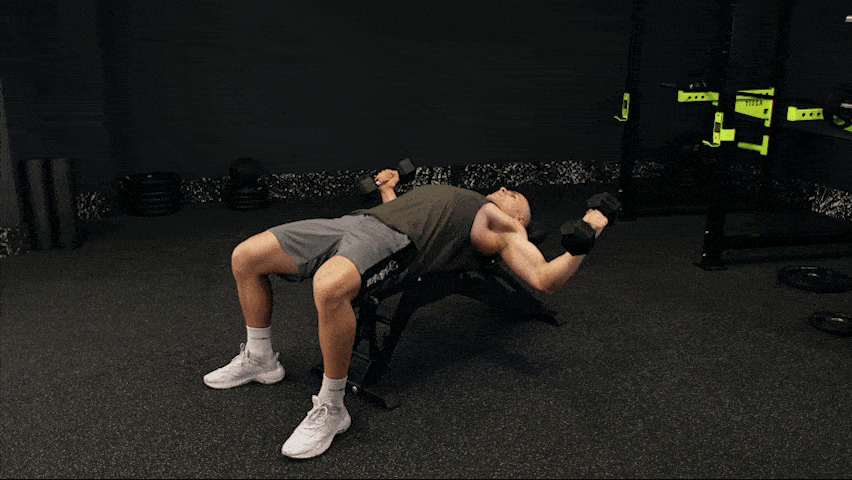
Other exercise variations:
1. Incline Bench Chest Fly
You can also perform chest fly on an incline bench for more varied training. If you lift it to a positive inclination (head up), you will work more on the upper part of the pectoral muscles. Otherwise, if you adjust the bench to a negative inclination (head upside down), you will engage the lower part of the chest more.
2. Pec Deck
You can replace dumbbells with an exercise performed on a machine known as Pec Deck. Sit with your back to the machine, spread your arms, and grab the handles. Adjust the position of the machine and the height of the seat so that your shoulders are in line with your stretched arms. Keep your elbows slightly bent. Pull your arms together by activating your pectoral muscles while exhaling. Return to the starting position while inhaling and repeat the movement.
You might be interested in these products:
3. Incline Dumbbell Chest Press
- Starting position: Lie on the incline bench (head up) with a 30–45 degree angle. Grab the dumbbells (overhand grip). Bend your arms and raise them below shoulder level. Palms point to the front. Rest your feet with the entire surface should be on the floor. Activate your core.
- Performance: Extend your arms forward by activating your pectoral muscles while exhaling. On the way up, push the dumbbells together. Return to the starting position with controlled movement while inhaling and move on to the next rep.
- Common mistakes: Uncontrolled movement, arched back, inappropriate weights, a small range of motion.
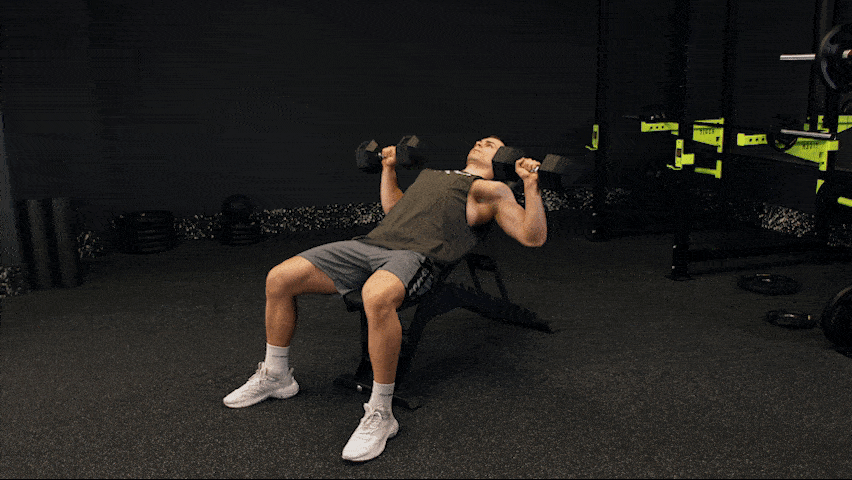
Other exercise variations according to primarily targeted area
1. Targeting the upper pectoral muscles
1.1. Incline Bench Press
Lie on the incline bench with a positive incline of 20–45 degree angle placed under the barbell on the stand. Grab the bar (overhand grip) and proceed the same way as with a classic bench press. The bar should touch your chest a little higher in the lower position in this variation.
1.2. Incline Kettlebell Chest Press
You can also replace dumbbells with two kettlebells in this exercise. Hold them by the handle and try to bring them closer in the upper position in the same way as dumbbells. If you only have one kettlebell or one dumbbell, exercise on one side first, then on the other.
2. Targeting the lower part of pectoral muscles
2.1. Decline Dumbbell Chest Press
Lie on the incline bench with a negative incline of 30–40 degrees. Grab the dumbbells and perform the same movement as with the incline dumbbell bench press.
2.2. Decline Bench Press
Lie on the incline bench with a negative incline of 30–40 degrees. Grab the bar placed on the stand (overhand grip) and proceed the same way as with a classic bench press.
4. Low Cable Chest Fly
- Starting position: Grab the handle of the low cable with each hand (overhand grip). Stand in the middle of the cable machines with your feet side by side. Keep your back straight. Keep the arms alongside the body, the elbows slightly bent, the palms facing each other and slightly up.
- Performance: Extend your arms forward by activating the pectoral muscles while exhaling. Try to get the pulleys in front of the chest or even the head. You can stay in this position for 1–2 seconds. Then return to the initial position while inhaling and move on to the next rep.
- Common mistakes: Uncontrolled movement, too bent elbows, bent back, a small range of motion, inappropriate weights.

Other exercise variations:
1. Expander Chest Fly
You can use long expanders instead of cable pulleys. All you need to do is attach them to the bottom of the vertical bar. You should pull expanders together in the same way. Remember that the bigger the resistance of the expander, the more challenging the exercise will be.
2. Single Arm Low Cable Fly
If you only have one cable pulley, you can perform this exercise on each side separately. In addition, this option allows you to focus more on your active muscles. You can also use one expander.
5. High Cable Chest Fly
- Starting position: Grab the handle of the high cable with each hand (overhand grip). Stand in the middle of the cable machines with split-stance and slightly bent knees. Bend over a little and keep your back curved naturally. Keep the arms are alongside the body, the elbows slightly bent, the palms facing each other and slightly up.
- Performance: Pull the cables together by activating the pectoral muscles while exhaling. The arms move downwards and forwards, and they meet in front of the body in the lower position. You can stay in this position for 1–2 seconds. Then return to the starting position while inhaling and move on to the next rep.
- Common mistakes: Uncontrolled movement, too bent elbows, bent back, a small range of motion, inappropriate weights.
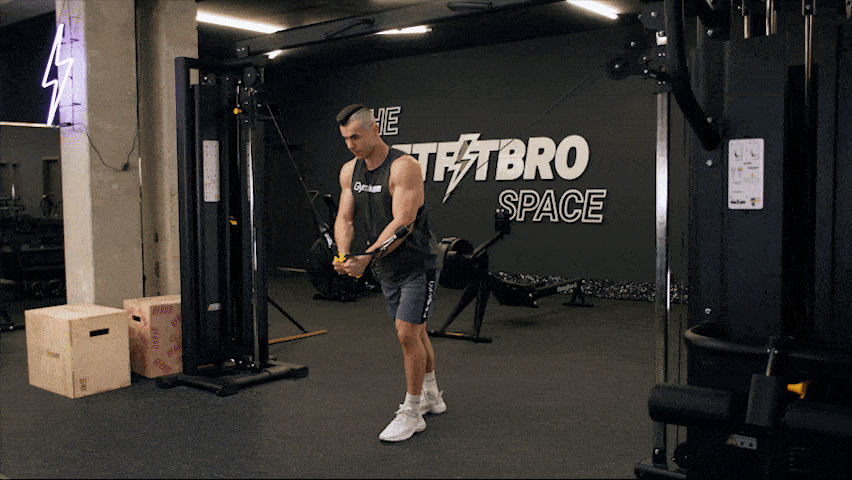
Other exercise variations:
1. Expander Chest Fly
You can also use long expanders instead of cable pulleys. All you need to do is attach them to the bottom of the vertical bar. You should pull them together in the same way. Remember that the bigger the resistance of the expander, the more challenging the exercise will be.
2. Single Arm High Cable Fly
If you only have one cable pulley, you can perform this exercise on each side separately. In addition, this option allows you to focus more on your working muscles. You can also use one expander.
6. Parallel Bar Dips
- Starting position: Do a support hold on the bars with extended arms. You can bend your legs slightly. The elbows point outwards. Keep your back straight.
- Performance: Bend your elbows while inhaling and go down with controlled movement until you are deeper than your shoulder level. Return to the starting position by activating the pectoral muscles while exhaling. Then move on to the next rep.
- Common mistakes: Elbows point inwards, uncontrolled movement, bent back, a small range of motion.

Other exercise variations:
1. Expander Dips
If the dips on the parallel bars are too demanding for you, you can make the exercise easier with a long expander. Attach one end of the band to the parallel bar and insert the other under your arm. Then do a support hold on the parallel bars and kneel on the stretched expander with one or both feet. Start making dips by activating your pectoral muscles. The bigger the resistance of the expander, the easier the exercise will be.
2. Weighted Dips
If bodyweight dips are too easy for you, add weight. Use a belt on which you can hang a plate or a kettlebell.
3. Ring Dips
If you do not have parallel bars available or want to diversify your training, you can try dips on rings. The exercise with rings is a bit more demanding, especially in terms of stability. You can make it easier by using attaching an expander.
7. Dumbbell Pullover
- Starting position: Place upper back on the side of the bench. Rest your feet with the whole surface on the floor and bend your knees. Extended your arms upwards and grab the dumbbell by the upper part (by plate/hexagon). Slightly bent the arms. Activate your core and glutes.
- Performance: Extend your arms forward by activating the pectoral muscles while exhaling. Return back to the starting position while inhaling and move on to the next rep.
- Common mistakes: Too bent elbows, uncontrolled movement, inappropriate load, bent back, a small range of motion.

Other exercise variations:
1. Plate or Kettlebell Pullover
If you do not have a dumbbell, use a place or kettlebell. In the case of a plate, grab it by the sides. And the kettlebell by the handle on the sides. Then perform the pullover in the same way as with the barbell.
2. EZ Bar Pullover
You can also do this exercise with a shorter EZ bar. Grab it in the middle with your arms at a distance less than the shoulder width. Then perform the pullover in the same way as with the barbell.
Other useful articles
- Are you interested in how to plan your training correctly? Then be sure to read our article How to Create a Quality Workout Plan – Tips, Trainings, Most Common Mistakes.
- To learn more about the ideal number of reps according to your goal, read our article How Many Reps Should You Do to Lose Weight or Gain Muscle?
- If your goal is to grow muscle mass, you should not miss our article What to Eat and How to Exercise to Finally Gain Muscle?
- Are you trying to gain muscle and still can’t? Then you should check our article 10 Tips for Healthy Weight Gain.
- Do you want to calculate your calorie and macronutrient intake according to your goal? Then our Online Energy Intake and Macronutrient Calculator will help you.
What should you remember?
Many people who go to the gym are striving for developed pectoral muscles. Effective chest exercises include bench press, dumbbell chest press, dips, and more. They will help you with complex muscle growth in this area, but also with strength and better shape. However, for better results, it is crucial to pay attention to the correct technique and gradually increase the load. That is the only way to achieve complex development of the pectoral muscles. Exercise your chest 2–3 times a week. Plan it so that you give the body enough space to regenerate.
Was this article helpful to you? If so, share it with your friends and show them the inspiration for pectoral muscle training with them.
[1] Burd, N. A., West, D. W. D., Moore, D. R., Atherton, P. J., Staples, A. W., Prior, T., Tang, J. E., Rennie, M. J., Baker, S. K., & Phillips, S. M. . Enhanced Amino Acid Sensitivity of Myofibrillar Protein Synthesis Persists for up to 24 h after Resistance Exercise in Young Men. – https://doi.org/10.3945/jn.110.135038
[2] Krzysztofik, M., Wilk, M., Wojdała, G., & Gołaś, A. Maximizing Muscle Hypertrophy: A Systematic Review of Advanced Resistance Training Techniques and Methods. – https://doi.org/10.3390/ijerph16244897
[3] Schoenfeld, B. J., Grgic, J., Van Every, D. W., & Plotkin, D. L. Loading Recommendations for Muscle Strength, Hypertrophy, and Local Endurance: A Re-Examination of the Repetition Continuum. – https://doi.org/10.3390/sports9020032


Add a comment